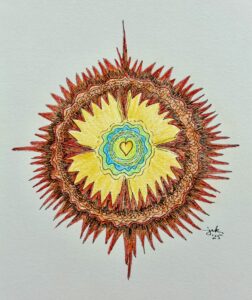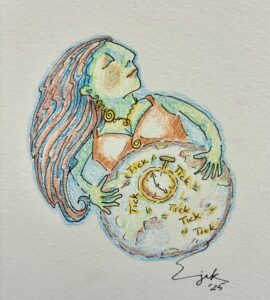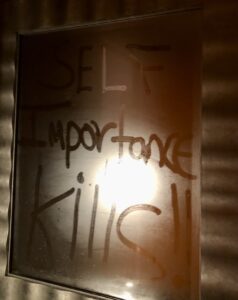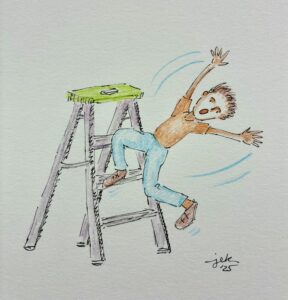
-Artwork © 2025 Jan Ketchel
Victor Frankl, survivor of four concentration camps during the Holocaust, gifted the world with the empirical truth that the inner freedom to think can literally save one’s life. Additionally, he established that no circumstance, however dire, could take that power to think away from anyone. Frankel’s discoveries are particularly relevant to our current world, itself approaching conditions of holocaust on many fronts.
Freedom to think is distinct from freedom to speak. Freedom of speech is extremely perilous in our present world, as it can be met with serious consequences, even death itself. Speaking is extraverted and therefore outwardly expressive. By contrast, thinking is an introverted, inward thought process that impacts the subconscious mind in the realm of the transpersonal Soul.
It is true that unspoken thoughts are themselves energetic entities that crowd the subtle atmosphere and attract the attention of receptive minds, such as through the practice of intentional healing prayer. However, even in this positive instance, targeted thought suggestions to the subconscious mind of another person will only be received if they resonate with that person’s values and beliefs.
Nonetheless, controls upon free speech and extreme propaganda, at the heart of the influencer industry, barrage the human mind incessantly with falsities targeted to control human belief and behavior. These persistent messages can take root and cloud access to one’s inner freedom to think clearly.
To avoid this type of barrage we are wisely advised to limit our exposure to emotionally charged rhetoric that seeks to hook our attention through fear mongering, and to direct our attention instead to our own inner thought processes. Inwardly, we are best advised to find calm in meditation, and truth through inner reflection and connection with our own true Spirit.
Robert Monroe, before each of his journeys into the subtle realms of infinity, always stated the intent that he would only accept an interaction with an entity that was at his level of morality and knowledge, or beyond, and that they should hold only benevolent intent. We can present these same suggestions to our own subconscious mind, with the intent to include both subtle thoughts and interactions, and to protect ourselves from outer world influencers as well, thus insuring maximum protection from undesirable influence, within and without.
The power of thought that Victor Frankl tapped into was the ability to manifest the life he suggested to his subconscious mind on the plane of the imagination, which he could live in and be supported by, as he navigated the horrors of life on the physical plane of existence, until the war ended.
His positive dissociation was hardly schizophrenic nor in denial of physical reality. Victor Frankl was already a practicing psychiatrist by the time he went into the concentration camps, acutely aware of reality in time and space, but he was able, through the power of imagination, to live in two planes of reality simultaneously.
In truth, we all exist simultaneously on several planes of existence. The current state of the world is concurrent with our awakening to the rarified energetic conditions of life on the astral plane, where the power of thought is the key to manifestation. As we move deeper into the Aquarian Age, our utilization of this power has the potential to completely change physical life on this planet.
We are presently at the beginning of such knowledge, but as shown in the accomplishments of Victor Frankl, we can utilize the extreme conditions of now to access the stupendous empowerment of our freedom to think, to both survive now and to manifest the world we truly want, through the power of the subconscious mind.
Best to keep your relation to your subconscious mind sacred and personal. That which we talk about inevitably attracts the energy of resistance. The containment of a suggestion within the womb of self allows it to mature, without interference, and to be born when it is truly due.
May your suggestions also be impregnated with the intent for the greater good of all.
Quietly exercising,
Chuck




